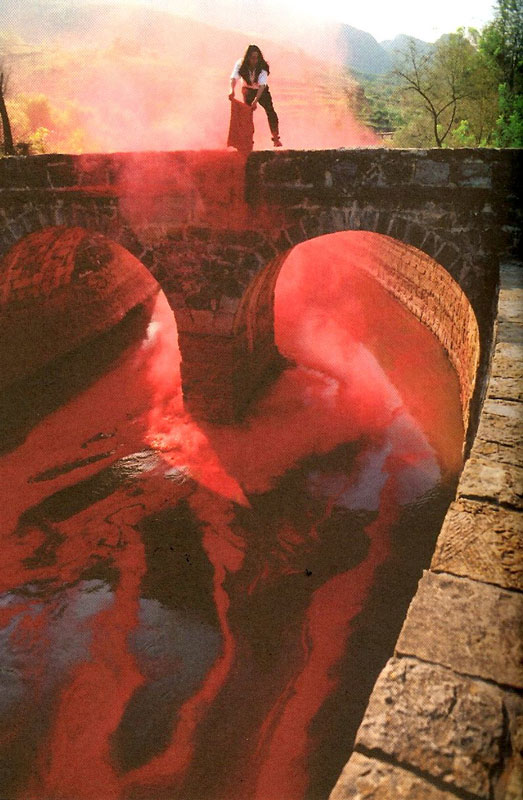Contemporary Chinese Art- another kind of view
DSL Collection
Red Flag Canal
More information on the works
More information on the works
"A triptych of three photographs shows a man standing on a bridge pouring down some red substance into a small canal full of muddy water. What started as a little red cloud develops into a long red stream causing many - mostly uncomfortable - thoughts in the onlooker.
This triptych is a 2001 copy of a set of photographs documenting a performance that took place 15 August 1994 in Taixing, a remote place in Henan province. Standing on the bridge Wang Jin poured 25 kg of organic pigment down into the canal, creating a nearly 3 km long stream of deep red water. The bridge has a particular meaning as it was constructed under primitive conditions during the Cultural Revolution to demonstrate the peoples? determination in advancing socialism. It is before such a background that Wang?s artistic act gains meaning. Obviously red is THE colour of socialism, it is THE colour of the 1960s and of the Cultural Revolution as it is the colour of blood that was spread so much during these violent years. Red is also the colour of happiness and wellbeing in Chinese public culture. Wang?s performance opens up a mental space allowing the viewer to contemplate on the many possibilities of meaning of a blood red muddy stream beneath a bridge that was built by people whose hopes had been sourly disappointed in the very process of their work.
This performance has been typical for the avant-garde of the early 1990s as it happened with a small audience and only gained prominence through the display of photographs. Wang staged his most famous performance in Zhengzhou, the capital of Henan province, in 1996 when he erected a 90 m long wall of ice-blocks in which he froze commodities. Onlookers then quickly destroyed the wall in their desperate attempt to lay hand on the goods. Today Wang concentrates on sculptures and installations like The Chinese Dream, a series of Beijing Opera robes, made of transparent PVC. Again, Wang connects features of contemporary society with traits of the past, which still have not lost their meaning for today?s China."
Christof Buettner
?I did the Red Flag Canal in 1994.That was in August,in Henan Province,in Lingxian, and was based on a famous revolutionary story. This is a site well-known in Chinese Cultural Revolution lore.
My idea at the time was to find a way to divert the waters of the Yellow River to the north, towards Taiheng Mountain.For me, this intervention with the river was a symbol of revolutionary fervor and largess. I used 50 kilos of blocks of red dye which I used to really paint the river red - to literalize and to memorialize the revolutionary slogan.
Symbolizing blood lost in the river, and the blood pumping through our veins, this was a way of showing the reality of one's life?.
wang jin
This triptych is a 2001 copy of a set of photographs documenting a performance that took place 15 August 1994 in Taixing, a remote place in Henan province. Standing on the bridge Wang Jin poured 25 kg of organic pigment down into the canal, creating a nearly 3 km long stream of deep red water. The bridge has a particular meaning as it was constructed under primitive conditions during the Cultural Revolution to demonstrate the peoples? determination in advancing socialism. It is before such a background that Wang?s artistic act gains meaning. Obviously red is THE colour of socialism, it is THE colour of the 1960s and of the Cultural Revolution as it is the colour of blood that was spread so much during these violent years. Red is also the colour of happiness and wellbeing in Chinese public culture. Wang?s performance opens up a mental space allowing the viewer to contemplate on the many possibilities of meaning of a blood red muddy stream beneath a bridge that was built by people whose hopes had been sourly disappointed in the very process of their work.
This performance has been typical for the avant-garde of the early 1990s as it happened with a small audience and only gained prominence through the display of photographs. Wang staged his most famous performance in Zhengzhou, the capital of Henan province, in 1996 when he erected a 90 m long wall of ice-blocks in which he froze commodities. Onlookers then quickly destroyed the wall in their desperate attempt to lay hand on the goods. Today Wang concentrates on sculptures and installations like The Chinese Dream, a series of Beijing Opera robes, made of transparent PVC. Again, Wang connects features of contemporary society with traits of the past, which still have not lost their meaning for today?s China."
Christof Buettner
?I did the Red Flag Canal in 1994.That was in August,in Henan Province,in Lingxian, and was based on a famous revolutionary story. This is a site well-known in Chinese Cultural Revolution lore.
My idea at the time was to find a way to divert the waters of the Yellow River to the north, towards Taiheng Mountain.For me, this intervention with the river was a symbol of revolutionary fervor and largess. I used 50 kilos of blocks of red dye which I used to really paint the river red - to literalize and to memorialize the revolutionary slogan.
Symbolizing blood lost in the river, and the blood pumping through our veins, this was a way of showing the reality of one's life?.
wang jin

